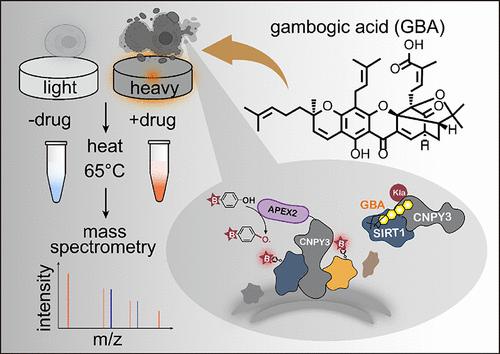当前位置:
X-MOL 学术
›
J. Med. Chem.
›
论文详情
Our official English website, www.x-mol.net, welcomes your feedback! (Note: you will need to create a separate account there.)
Thermal Proteome Profiling Strategy Identifies CNPY3 as a Cellular Target of Gambogic Acid for Inducing Prostate Cancer Pyroptosis
Journal of Medicinal Chemistry ( IF 7.3 ) Pub Date : 2024-03-21 , DOI: 10.1021/acs.jmedchem.4c00140 Xiao-Wen Zhang 1 , Ling Li 1 , Min Liao 1 , Dan Liu 2 , Asma Rehman 3 , Yang Liu 4 , Zheng-Ping Liu 5 , Peng-Fei Tu 1 , Ke-Wu Zeng 1
Journal of Medicinal Chemistry ( IF 7.3 ) Pub Date : 2024-03-21 , DOI: 10.1021/acs.jmedchem.4c00140 Xiao-Wen Zhang 1 , Ling Li 1 , Min Liao 1 , Dan Liu 2 , Asma Rehman 3 , Yang Liu 4 , Zheng-Ping Liu 5 , Peng-Fei Tu 1 , Ke-Wu Zeng 1
Affiliation

|
There is an urgent requirement to acquire a comprehensive comprehension of novel therapeutic targets for prostate cancer to facilitate the development of medications with innovative mechanisms. In this study, we identified gambogic acid (GBA) as a specific pyroptosis inducer in prostatic cancer cells. By using a thermal proteome profiling (TPP) strategy, we revealed that GBA induces pyroptosis by directly targeting the canopy FGF signaling regulator (CNPY3), which was previously considered “undruggable”. Moreover, through the utilization of the APEX2-based proximity labeling method, we found that GBA recruited delactatease SIRT1, resulting in the elimination of lysine lactylation (Kla) on CNPY3. Of note, SIRT1-mediated delactylation influenced the cellular localization of CNPY3 to promote lysosome rupture for triggering pyroptosis. Taken together, our study identified CNPY3 as a distinctive cellular target for pyroptosis induction and its potential application in prostate cancer therapy.
中文翻译:

热蛋白质组分析策略将 CNPY3 确定为藤黄酸诱导前列腺癌焦亡的细胞靶标
迫切需要全面了解前列腺癌的新治疗靶点,以促进具有创新机制的药物的开发。在这项研究中,我们发现藤黄酸(GBA)是前列腺癌细胞中一种特异性焦亡诱导剂。通过使用热蛋白质组分析(TPP)策略,我们发现GBA通过直接靶向冠层FGF信号调节因子(CNPY3)来诱导细胞焦亡,而该调节因子以前被认为是“不可成药的”。此外,通过利用基于APEX2的邻近标记方法,我们发现GBA招募了脱乳酸酶SIRT1,从而消除了CNPY3上的赖氨酸乳酰化(Kla)。值得注意的是,SIRT1 介导的脱乙酰化影响了 CNPY3 的细胞定位,从而促进溶酶体破裂,从而引发细胞焦亡。综上所述,我们的研究确定 CNPY3 是诱导焦亡的独特细胞靶点及其在前列腺癌治疗中的潜在应用。
更新日期:2024-03-22
中文翻译:

热蛋白质组分析策略将 CNPY3 确定为藤黄酸诱导前列腺癌焦亡的细胞靶标
迫切需要全面了解前列腺癌的新治疗靶点,以促进具有创新机制的药物的开发。在这项研究中,我们发现藤黄酸(GBA)是前列腺癌细胞中一种特异性焦亡诱导剂。通过使用热蛋白质组分析(TPP)策略,我们发现GBA通过直接靶向冠层FGF信号调节因子(CNPY3)来诱导细胞焦亡,而该调节因子以前被认为是“不可成药的”。此外,通过利用基于APEX2的邻近标记方法,我们发现GBA招募了脱乳酸酶SIRT1,从而消除了CNPY3上的赖氨酸乳酰化(Kla)。值得注意的是,SIRT1 介导的脱乙酰化影响了 CNPY3 的细胞定位,从而促进溶酶体破裂,从而引发细胞焦亡。综上所述,我们的研究确定 CNPY3 是诱导焦亡的独特细胞靶点及其在前列腺癌治疗中的潜在应用。



























 京公网安备 11010802027423号
京公网安备 11010802027423号